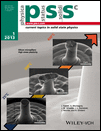Dislocations in 4H- and 3C-SiC single crystals in the brittle regime
Abstract
Nanoindentations at room temperature have been performed on 4H- and 3C-SiC single crystals, and resulting microstructures have been analyzed by Transmission Electron Microscopy. In both structures, dislocations emitted from imprints are perfect dislocations lying in the basal plane for 4H- and in the {111} planes for 3C-SiC. Dislocation segments are not dissociated and they are assumed to be lying in the shuffle set where only one bound per atom has to be cut for dislocation motion. It is deduced that the low stacking fault energy of silicon carbide is not involved in plasticity under high stress as compared to high temperature behaviour. The change in deformation mechanism reported in this study indicates that silicon carbide exhibits the same behaviour under high stress as other semiconducting materials, as silicon or antimonide indium. This could be a general feature for all this family of materials (© 2013 WILEY-VCH Verlag GmbH & Co. KGaA, Weinheim)




